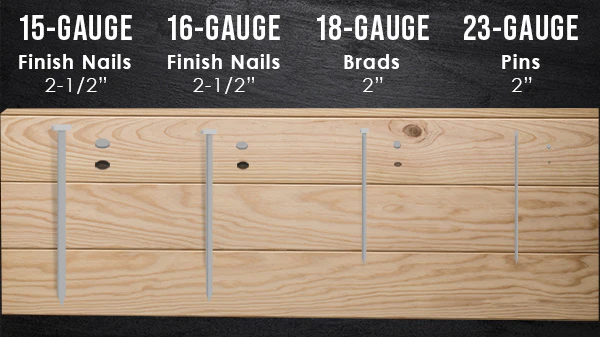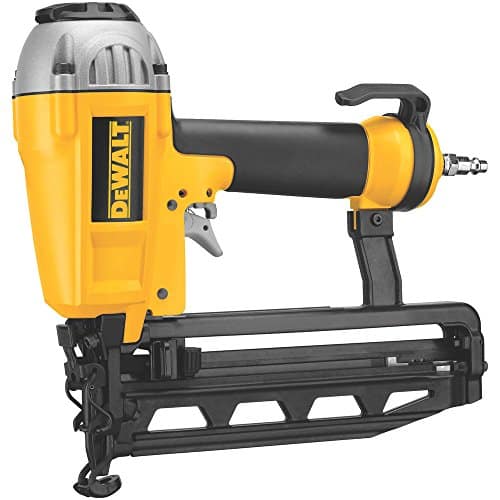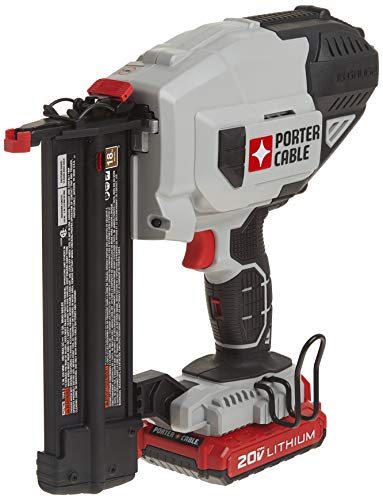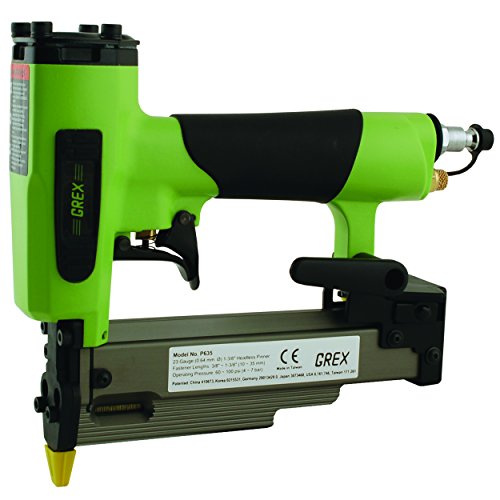Brad Nailer vs Finish Nailer vs Pin Nailer: Which One to Use for Your Next Project?
As a DIY enthusiast, I understand how overwhelming it can be to choose the right nail gun for your project.
With so many options available, it’s easy to get confused and make the wrong choice.
That’s why I’m here to help you understand the differences between finish, brad, and pin nailers (and crown staplers) and guide you towards choosing the best one for your workshop and which nail gun to use for your upcoming projects.
Whether you’re a beginner or an experienced DIYer, you’ll find this guide helpful in choosing the right tool for your needs.
So, let’s dive in and explore the world of nail guns!
Key Takeaways
- There are different types of nail guns available, including finish, brad, and pin nailers (and crown staplers).
- The type of nail gun you should use depends on the project you’re working on.
- Understanding the differences between each type of nail gun is crucial in making the right choice for your workshop.
What Types of Nail Guns are Available?
There are many types of nail guns available for different purposes.
I will focus on the three most common types of nail guns used in woodworking, furniture building, and DIY projects – finish nailers, brad nailers, and pin nailers.
Finish Nailers
Finish nailers are designed to shoot longer and thicker nails, typically ranging from 15 to 16 gauge. They are commonly used for trim work, baseboards, and crown molding.
Brad Nailers
Brad nailers, on the other hand, shoot smaller and thinner nails, usually 18 gauge. They are ideal for delicate woodworking projects, such as attaching thin pieces of wood or trim to a surface.
Pin Nailers
Pin nailers shoot even smaller nails, usually 23 gauge. They are perfect for attaching delicate pieces of trim or other small decorative elements to a surface. They leave virtually no visible holes and are great for finishing touches.
Which One is Best? BRAD NAILER VS FINISH NAILER VS PIN NAILER
When it comes to nail guns, there is no one-size-fits-all solution.
Each type of nail gun has its own set of pros and cons, and it all depends on what you plan to use it for.
If you’re looking for a versatile option that can handle a range of projects then I would say…
The 18 gauge nailer is probably your best bet.
As a woodworker, I find myself using the 18 gauge nailer most frequently.
It’s small enough for trim work, but can also handle larger projects if used in conjunction with glue.
That being said, if you’re working on a project that requires heavier-duty nails, you may want to consider a different type of nail gun.
If you’re just starting out and looking to add a nail gun to your collection, I recommend starting with the 18 gauge nailer.
It’s a great all-purpose option that can handle a variety of DIY projects, from carpentry to woodworking.
And if you opt for a battery-powered nail gun, be sure to stick with the same brand as you add to your collection to ensure that the batteries are all interchangeable.
Overall, there is no one “best” nail gun – it all depends on your specific needs and preferences.
But with a little research and experimentation, you’re sure to find the perfect tool for your next DIY project.
FINISH VS. BRAD VS. PIN NAILS
When it comes to selecting the right nail gun for your project, it’s essential to understand the differences between the various types of nails available.
The thickness or diameter of the nail is the primary sizing reference, not the length.
The following are the most common types of nails and their gauges:
Brandon’s Top Tip: As the gauge number increases, the size of the nail decreases.
- FINISH NAILS: 15 and 16 gauge
- BRAD NAILS: 18 gauge
- PIN NAILS: 23 gauge
What about holding power?
As a result, finish nails (15 or 16 gauge) have a higher holding strength than brad nails (18 gauge).
Pin nails, which are 23 gauge, are exceptionally small compared to even the 18 gauge brad nails. Pin nails are ideal for delicate trim work where visible nail holes are undesirable. However, it’s worth noting that pin nails have limited holding power and are not suitable for heavy-duty applications.
In my shop, I have a 16 and 18 gauge (finish and brad) nailer.
Below is a visual comparison of the types of nails.

Battery vs. Air Nailers
As a DIY enthusiast, I have used both battery and air nailers extensively and have come to appreciate the advantages and disadvantages of each.
Here’s a breakdown of the key differences between the two:
Power Source
Air Nailers
Air nailers require a compressor to function, which means you need access to electricity and you’ll need to drag the compressor with you wherever you go.
Battery Nailers
Battery nailers have a built-in compressor that runs on a rechargeable battery, making them cordless and more convenient to use.
Cost
Air Nailers
Air nailers are generally cheaper than battery nailers, but keep in mind that you’ll also need to factor in the cost of a compressor.
Battery Nailers
Battery nailers are more expensive upfront, but you’ll save money in the long run since you won’t need to purchase a compressor or pay for electricity.
Performance
Both types of nailers can handle a variety of tasks, but air nailers tend to be more powerful and better suited for heavy-duty projects.
However, battery nailers are still capable of handling most DIY projects and are more than adequate for most users.

A cool thing about this nailer is the sealed lube dial technology. This means that the motor can work both with and without lubricating oil. This helps keep maintenance minimal and makes the tool all that much more versatile.
What Do You Use Finish Nailers For?
As a woodworker, I often use finish nailers to attach trim and molding to my projects. Finish nailers are designed to shoot thicker nails, usually 15 or 16 gauge, which are ideal for thicker and denser materials like hardwoods and 1x boards.
One of my favorite finish nailers is the Ryobi 16 gauge AirStrike battery nailer. I recently used it to install window and door trim in my shop, and the larger nail held the thicker 1×4 and 1×6 material in place without the need for wood glue.
Finish nailers are also great for installing baseboards, crown molding, and trim boards on accent walls. They can even be used for assembling small wooden boxes and attaching face frames to cabinets.
While the larger nail leaves a bigger hole, this can easily be covered up with a little putty and paint, making it a minor issue.
Finish nailers are a great tool for any woodworker looking to add a professional touch to their finish work, from flooring to door casings.

100% Battery Power Of The Cordless Brand Nailer Eliminates Need For Compressor, Hose Or Costly Gas Cartridges. Multiple Tool-Free Settings Of The Battery Brad Nailer Provide Ease Of Use.
What Do You Use a Brad Nailer For?
As a woodworker, I often use a brad nailer for various projects. A brad nailer is an 18 gauge nail gun that shoots smaller nails than a finish nailer. These smaller nails are perfect for thinner, lighter weight, and more delicate pieces like cove molding, crown molding, and other small molding details.
I personally use the Ryobi 18 gauge AirStrike battery nailer, which I have been using for the last 4-5 years. Recently, I used it to attach small half round and crown molding details to the main frame of the trim when I installed window trim.
The smaller brad nails leave a smaller hole to fill, and they are much less likely to damage or split small wood pieces like a larger 16 gauge nail might. While brad nails don’t have as strong of a holding power as finish nails, they are perfect for small pieces that don’t need it.
However, you can use brad nails along with wood glue to give you very good holding power on heavier pieces depending on the application you’re using it with. Brad nailers are great for attaching thin, delicate pieces of wood together, and for assembling small wood projects, as long as you also use some glue.
Overall, a brad nailer is a versatile tool that can be used for various woodworking projects, including adding small molding details, attaching thin, delicate pieces of wood together, and for assembling small wood projects.

Powerful motor penetrates fasteners through the hardest materials. Shoots fasteners up to 1-3/8-inch lengths easily, even-inch hardwoods. Patented design eliminates the need to adjust for different fastener lengths.
What Do You Use a Pin Nailer For?
As a woodworking enthusiast, I have found that a pin nailer is an essential tool in my shop. Pin nailers are specialized tools that can be used for delicate projects and thin materials. They are ideal for working with veneers and other thin materials since they leave very small holes that do not require puttying over.
Pin nails are very small and cannot hold much weight on their own. However, they are great for “pinning” a piece in place to check the fit before gluing. They can also be used to hold things in place while glue dries without leaving much of a mark.
When working alone, a pin nailer can be an extra set of hands and allow you to “pin it” in place while you check the fit or mark where to cut. You can simply pop it off and remove the nails when you don’t need them anymore.
Pin nailers are also useful for installing long pieces of molding or a board. They can help you to hold the piece in place while you check the fit or mark where to cut.
In summary, pin nailers are ideal for delicate projects, thin materials, and for holding pieces in place while glue dries. They are a must-have tool for any woodworking enthusiast who wants to achieve professional results.
What About Staplers?
As a woodworker, I recently added the Ryobi AirStrike 18 gauge crown stapler to my shop.
Although it shoots staples instead of nails, it functions just like a nail gun and has similar uses. The term “crown stapler” refers to the type of staple, which has a rounded top and is narrow.
These small staples are ideal for various tasks, including
- upholstery
- attaching mesh
- paper or thin materials to wood
- or installing thin wood panels such as ¼” plywood or beadboard onto projects.
They can also be used to attach thin moldings, and since it’s a staple, it provides better hold than a nail.
I have been using a hand stapler for many projects around the shop, but having a battery stapler like the Ryobi AirStrike crown stapler will give my hands a much-needed rest.
Frequently Asked Questions
What are the primary uses for a pin nailer compared to brad and finish nailers?
A pin nailer is primarily used for delicate woodworking tasks such as attaching trim, molding, and other small decorative pieces. Pin nailers use very small, thin nails that leave virtually no visible holes, making them ideal for tasks where appearance is important. In contrast, brad and finish nailers are used for larger tasks such as attaching baseboards, crown molding, and window casings.
How do brad nailers differ from finish nailers in terms of nail size and application?
Brad nailers use smaller nails than finish nailers, typically ranging from 18 to 23 gauge. They are designed for attaching thinner pieces of trim and molding, and for tasks that require precision and a smaller nail hole. Finish nailers, on the other hand, use larger nails ranging from 15 to 16 gauge. They are used for heavier trim and moldings, such as baseboards and crown molding, and for attaching larger pieces of wood.
When should a brad nailer be used over a finish nailer for trim work?
A brad nailer should be used over a finish nailer when attaching thinner pieces of trim or molding, or when precision is important. Brad nails are smaller and leave a smaller hole, making them ideal for delicate work. Finish nailers should be used when attaching larger or heavier trim and molding, or when a stronger hold is needed.
What are the advantages of cordless brad nailers for DIY projects?
Cordless brad nailers offer the advantage of mobility and convenience. They are battery-powered, allowing for greater flexibility and ease of use, especially in areas where access to power outlets may be limited. Additionally, cordless brad nailers are typically lighter and easier to maneuver, making them ideal for DIY projects.
Can a pin nailer effectively replace a brad nailer for delicate woodworking tasks?
While a pin nailer can be used for delicate woodworking tasks, it cannot effectively replace a brad nailer. Pin nailers use very small nails that are not as strong as brad nails, and they are not designed for heavier trim or molding. In addition, pin nailers may not be suitable for certain types of wood, as the small nails may not provide enough support.
What is the appropriate nailer to use for installing baseboards and moldings?
The appropriate nailer to use for installing baseboards and moldings is a finish nailer. Finish nailers use larger nails that provide a stronger hold, making them ideal for attaching heavier pieces of trim and molding. Additionally, the larger nail holes can be easily filled and painted over, making them less noticeable than smaller nail holes.
Lorem ipsum dolor sit amet, consectetur adipiscing elit. Ut elit
Reader Interactions